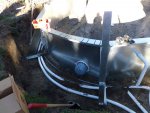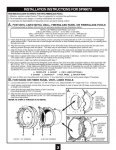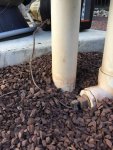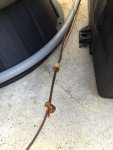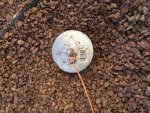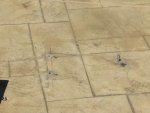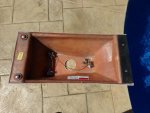Each day I dose the pool with approximately 3ppm of liquid chlorine, and adjusting every few days if necessary. On average, every 4 days, I have to add 10 oz. of Muriatic Acid to lower my PH down to 7.5. The color is usually between 7.6 & 7.8. Ironically the PH this year started at 7.2, raised it up slightly to 7.6 with 1/2 box of Borax. After this, it seemed like my PH was rising slowly until it was over 8.0-8.2. Because I could not see the difference of the colors, I always thought I was around 7.8 and not near 8.2. I started using dry acid and eventually switched to Muriatic Acid. Stabilizer increased as needed from 30-50 in the beginning of the season & now down to 40. The TA was at 140 in the beginning of the season and now down to about 100 because of all the acid additions. My goal is to get this down to about 80 to determine if the PH will hold. If not, I may add borates or remove the 4 rotating aerating heads that create a lot of little bubbles. This may not be accomplished this year. CH has gone down from 200 to about 125.
Question: Can the addition of liquid chlorine, mixing for 30 minutes and then muriatic acid in the deep end (in front of the return) mixed at the same time cause any type of electrical charge, or "electrolysis"? This is a non SWG pool.
I had an issue with rust dripping on the screws near the light niche. The electrician is coming to test everything out over the next few days with regards to the bonding and grounding of pool and lights, etc. The light has not been used at all and the second set of screws have no apparent rust on the heads. Once the electrician is done, I will turn on the light for at least 4-6 hours with filter running to determine if this is causing any problems with the screw heads. They were not rusting, just rust accumulation and/or dripping on the heads.
I was reading something about SWG pools, and all weird things can happen when the SWG is running, creating electricity and acid is added, combining with alkaline pools, etc. I am wondering if any of the combinations in my pool could have caused this? I understand that this could be far fetched, and maybe I am overthinking this whole process. Should I be adding the Muriatic Acid in any other way?
Hayward, who kindly sent me new screws, claims that they are stainless steel and something else is causing this problem and not the screws. Even though, the second set of screws were sprayed with a marine spray, there is no apparent rust that could have been caused by Galvanic Corrosion.
Thank you.
Question: Can the addition of liquid chlorine, mixing for 30 minutes and then muriatic acid in the deep end (in front of the return) mixed at the same time cause any type of electrical charge, or "electrolysis"? This is a non SWG pool.
I had an issue with rust dripping on the screws near the light niche. The electrician is coming to test everything out over the next few days with regards to the bonding and grounding of pool and lights, etc. The light has not been used at all and the second set of screws have no apparent rust on the heads. Once the electrician is done, I will turn on the light for at least 4-6 hours with filter running to determine if this is causing any problems with the screw heads. They were not rusting, just rust accumulation and/or dripping on the heads.
I was reading something about SWG pools, and all weird things can happen when the SWG is running, creating electricity and acid is added, combining with alkaline pools, etc. I am wondering if any of the combinations in my pool could have caused this? I understand that this could be far fetched, and maybe I am overthinking this whole process. Should I be adding the Muriatic Acid in any other way?
Hayward, who kindly sent me new screws, claims that they are stainless steel and something else is causing this problem and not the screws. Even though, the second set of screws were sprayed with a marine spray, there is no apparent rust that could have been caused by Galvanic Corrosion.
Thank you.




